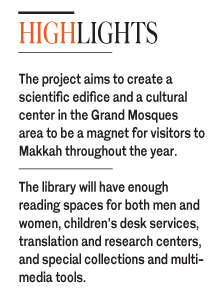JEDDAH: The library of Makkah Grand Mosque, which is affiliated with the General Presidency for the Affairs of the Grand Mosque and the Prophet’s Mosque, is one of the oldest libraries in the Islamic world. It was established during the second century AH at the beginning of the Abbasid period in 160 AH.
It was named the Library of Makkah Grand Mosque in 1357 AH when King Abdul Aziz bin Abdul Rahman Al-Saud set up a committee of Makkah scholars to study its conditions and organize it in accordance with its status and importance.
The library began under one of the domes of the Grand Mosque dedicated to the preservation of copies of the Qur’an.
In 1357 AH the library moved for the first time outside the Grand Mosque to become affiliated with the Ministry of Hajj until 1385 AH, when it was affiliated with the General Presidency of Religious Supervision at the Grand Mosque. It then changed its name to the General Presidency for the Affairs of the Grand Mosque and the Prophet’s Mosque and became a public library to serve students of religion.
The establishment of the Library of Makkah Grand Mosque project near the Grand Mosque and within the historical expansion project of the Grand Mosque affirms the status of the two Holy Mosques and the state’s keenness to take care of them and of the system of services provided and the scholarly and historical importance of the library.
The establishment of the library near the Grand Mosque came as a permanent substitute for the rented building, according to the full designs and engineering plans of the project which are reflected in the finest style, the best level and most creative design worthy of the status of the Grand Mosque and everything related to it, especially the ancient library of the Grand Mosque, which has served knowledge and scholars for about 12 centuries. 
The project is located on the Kaaba Mountain Road on the northwestern side of the services building for the third Saudi expansion project and is crossed by the first ring road.
The multi-purpose library project aims to establish a scientific center and a world-class cultural and knowledge center in the holy capital centered on a central library of 20 million titles.
The project includes the lower service floors, the transport station and several other floors. There are other components of the cultural center such as the exhibition hall, the museum, the planetarium and the galleries.
It also has a large reading hall, a multi-story tower that includes bookshops, specialized bookshelves, research and translation centers, administrative offices, a conference center and a large lecture hall with all attendant services for more than 1,000 beneficiaries.
The library’s main entrance is on the Kaaba Mountain road and from the upper deck of the expansion project building. This will directly connect with the yards of the Grand Mosque. There will also be a back entrance from the proposed road linking the site to Omar bin Abdul Aziz Street.
The project aims to create a scientific edifice and a cultural center in the Grand Mosques area to be a magnet for visitors to Makkah throughout the year.
The project reflects the interest of the leadership in science and its students and translates the efforts and projects carried out by the state in the two Holy Mosques to achieve the objectives set for them. It provides a central library of world-class orientation, using the latest technologies, including nearly 20 million volumes of “books and manuscripts” with enough reading spaces for both men and women, offering the latest in the world of research tools and services.
All potential will be harnessed to make the library a cultural center with the largest number of visitors in the region — both residents of Makkah and visitors from all over the world — by focusing on the ideal diversity between cultural uses and services required and providing services such as the planetarium, galleries and modern technology screens.
The library will have enough reading spaces for both men and women, children’s desk services, translation and research centers, high-tech storage, delivery and receipt of folders, special collections and multi-media tools, as well as specialized services of the library with the latest scientific means, a manuscripts and digital library, a department for rehabilitation and restoration of ancient manuscripts and adequate administrative space.
The library, in its present location, has 15 sections serving readers and researchers to help them access library information, books, manuscripts, periodicals, lessons and audio speeches.
Rare books have been digitised to offer fast service in line with expansion technologies and digital information storage to accommodate 160,000 books, 5,314 original and photocopied manuscripts, 2,500, and 40,000 periodicals.
The General Presidency for the Affairs of the Grand Mosque and the Prophet’s Mosque has been keen that people with special needs benefit from the services provided by the library through the allocation of a pavilion that cares for the blind and the disabled with books and brochures printed in braille and audio tapes, including more than 2,300 tapes and 700 books in science and literature.





























